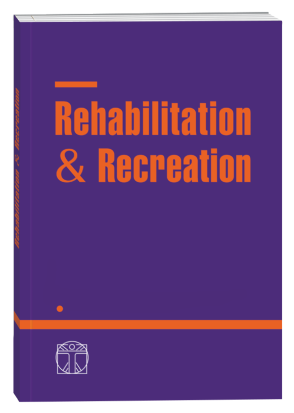VAGUS ACTIVATION AS A MEANS OF CORRECTION OF NEUROGENIC-BORNE ARRHYTHMIAS
DOI:
https://doi.org/10.32782/2522-1795.2024.18.6Keywords:
arrhythmias, stress, diaphragmatic breathing, vagusAbstract
The article considers the possibility of using technique of diaphragmatic breathing “vacuum” for the prophylaxis and correction of neurogenic-borne arrhythmias. It is noted that under the influence of chronic stress, the tone of the sympathetic nervous system inevitably increases, what negatively affects the regulation of the cardiovascular system and leads to rhythm disturbances. By controlling breathing, it is possible to indirectly influence the tone of the sympathetic and parasympathetic divisions of the autonomic nervous system. The direct effect on heart rate is caused by a change in the vagal tone. In the walls of the esophagus, stomach and bowels there are numerous fibers of the vagal nerve, which are actively stimulated during the “vacuum” exercise. This causes a strong and rapid parasympathetic effect. The purpose of the research is correction of neurogenic-borne arrhythmias using technique of diaphragmatic “vacuum” breathing and providing recommendations for preventing the progress of these arrhythmias. Research material and methods: analysis of methodological literature and information sources by the research topic; instrumental research methods; analysis of temporal and spectral indicators of heart rate variability of investigated people (n=19); methods of mathematical statistics. The results. The importance of breathing in the mediated effect on the shift in the ratio of sympatho-parasympathetic influences on the regulation of the cardiovascular system and heart rhythm is shown. The dynamics of the following investigated indicators were analyzed: heart rate, frequency domain indicators (Hz) – VLF, LF, HF, TR, which reflect the activity of neurohumoral influences on the heart rhythm; values of the maximum amplitude of spectral peaks (ms2/Hz) – VLF, LF, HF and the index of vagosympathetic interaction LF/HF; RRNN – average duration of RR intervals; SDNN is the standard deviation of the values of normal RR intervals. Conclusions. The analysis of the obtained experimental data allows to recommend the use technique of “vacuum” diaphragmatic breathing for the prevention and correction of neurogenic-borne arrhythmias. As part of neuromodulation vagus activation can be used in the treatment of such diseases as depression, obesity, diseases of the gastrointestinal tract, lung diseases, which can complicate the course of cardiac pathology, as well as stress. We consider that vagus activation can be used in complex treatment, in combination with traditional drug therapy approaches.
References
Іонов І.А., Комісова Т.Є. Фізіологія кардіореспіраторної системи : методичні рекомендації. Харків : ФОП Петров В.В., 2018. 66 с.
Лутай М.І., Голікова І.П., Швидка М.П. Стрес та стрес, пов’язаний з воєнними діями: вплив на серцево-судинні захворювання та ІХС : монографія / за ред. В.М. Коваленко. Київ, 2022. C. 168–191. URL: Stres-isertsevo-sudynni-zakhvoriuvannia-v-umovakhvoiennoho-stanu-szhat-y.pdf.
Страколист Г.М., Богдановська Н.В., Бессарабова О.В. Вплив діафрагмального дихання на стан ендотелію судин у молодих жінок з есенціальною гіпертензією. Rehabilitation and Recreation, 2023. №. 15. С. 111–117. DOI: 10.32782/2522-1795.2023.15.14.
Талаєва Т.В., Третяк І.В., Василинчук Н.М., Вавілова Л.Л. Патогенетичні механізми розвитку та прогресування серцево-судинної патології в умовах стресу. ІХС : монографія / за ред. В.М. Коваленко. Київ, 2022. С. 24–39. URL: Stres-isertsevo-sudynni-zakhvoriuvannia-v-umovakhvoiennoho-stanu-szhat-y.pdf.
Chakraborty Р., Farhat К., Morris L. et al. Non-invasive Vagus Nerve Simulation in Postural Orthostatic Tachycardia Syndromehttps. Arrhythmia & Electrophysiology Review. 2023. № 12. P. 31–38. DOI: 10.15420/aer.2023.20.
Gabriel M., Hurtado Р. et al. Speechinduced atrial tachycardia: A narrative review of putative mechanisms implicating the autonomic nervous system. Heart Rhythm O2. 2023. № 4(9), P. 573–580. DOI: 10.1016/j.hroo.2023.07.006.
Garg P., Claxton J., Soliman et al. Associations of anger, vital exhaustion, antidepressant use, and poor social ties with incident atrial fibrillation: The Atherosclerosis Risk in Communities Study. European Journal of Preventive Cardiology. 2021. № 28 (6), P. 633–640. DOI: 10.1177/2047487319897163.
Kaniusas E. Current Directions in the Auricular Vagus Nerve Stimulation I – A Physiological Perspective. Neuroscience. 2019. № 13. Аrticle 854. DOI: 10.3389/fnins.2019.00854.
Marcelo H.A. Ichige, Carla R. Santos et al. Exercise training preserves vagal preganglionic neurones and restores parasympathetic tonus in heart failure. Journal Physiology. 2016. № 594 (21)ю P. 6241–6254. DOI: 10.1113/JP272730.
Patterson E. Sodium-calcium exchange initiated by the Ca 2+ transient: an arrhythmia trigger within pulmonary veins. Journal of the American College of Cardiology. 2006. № 47(6). P. 1196–1206.
Suna G., Mellor G. Explaining the Unexplained: A Practical Approach to Investigating the Cardiac Arrest Survivor. Arrhythmia & Electrophysiology Review. 2023. № 12. P. 27–34. DOI:10.15420/aer.2023.06.
Prinzen F. Electro-energetics of Biventricular, Septal and Conduction System Pacing. Arrhythmia & Electrophysiology Review. 2021. № 10(4), P. 250–257. DOI: 10.15420/aer.2021.30.
Stavrakis S., Stoner J., Humphrey M. et al. TREAT AF (Transcutaneous Electrical Vagus Nerve Stimulation to Suppress Atrial Fibrillation): A Randomized Clinical Trial. JACC Clinical Electrophysiol. 2020. № 6 (3). P. 282–291.
Zhang Y., Huang Y. et al. Transcutaneous auricular vagus nerve stimulation (taVNS) for migraine: an fMRI study. Regional Anesthesia & Pain Medicine. 2021. № 46 (2). P. 145–150. DOI: 10.1136/rapm-2020-102088.
2019 ESC Guidelines for the management of patients with supraventricular tachycardia. The Task Force for the management of patients with supraventricular tachycardia of the European Society of Cardiology (ESC) developed in collaboration with the Association for European Pediatric and Congenital cardiology (AEPC). European Heart Journal. 2020. № 41. P. 655–720. DOI: 10.1093/eurheartj/ehz467.
Downloads
Published
How to Cite
Issue
Section
License

This work is licensed under a Creative Commons Attribution-NonCommercial-NoDerivatives 4.0 International License.











